Trading strategies
Explore practical techniques to help you plan, analyse and improve your trades.
Our library of trading strategy articles is designed to help you strengthen your market approach. Discover how different strategies can be applied across asset classes, and how to adapt to changing market conditions.


Most traders understand EA portfolio balance through the lens of traditional risk management — controlling position sizes, diversifying currency pairs, or limiting exposure per trade.
But in automated trading, balance is about deliberately constructing a portfolio where different strategies complement each other, measuring their collective performance, and actively managing the mix based on those measurements.
The goal is to create a “book” of EAs that can help diversify performance over time, even when individual strategies hit rough patches.
A diversified mix of EAs across timeframes and assets can, in some cases, reduce reliance on any single strategy. This approach reduces dependency on any single EA’s performance, smooths your overall equity curve, and builds resilience across changing market conditions.
It’s about running the right mix, identifying gaps in your coverage, and viewing your automated trading operation as an integrated whole rather than a collection of independent systems.
Basic Evaluation Metrics – Your Start Point
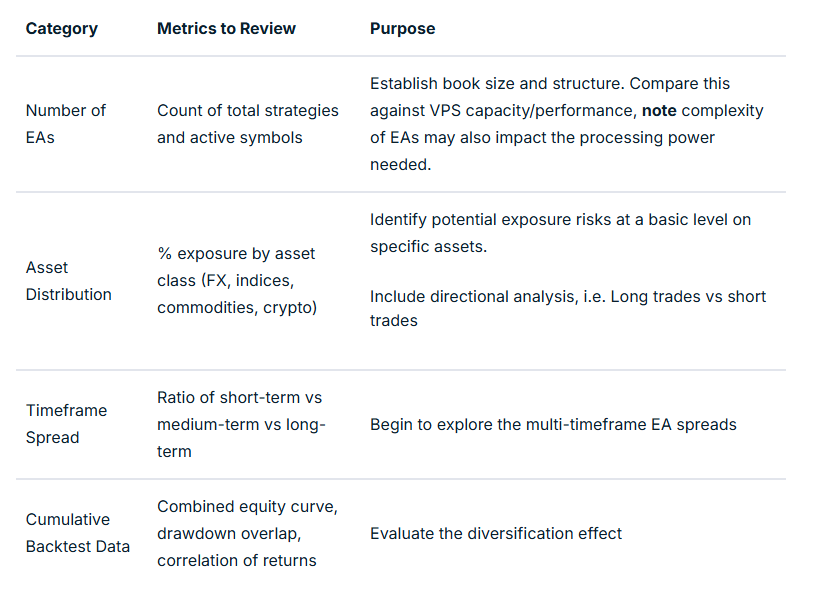
Temporal (timeframe) Balancing
When combined, a timeframe balance (even on the same model and instrument) can help flatten equity swings.
For example, a losing phase in a fast-acting M15 EA can often coincide with a profitable run in an H4 trend model.
Combining this with some market regime and sessional analysis can be beneficial.
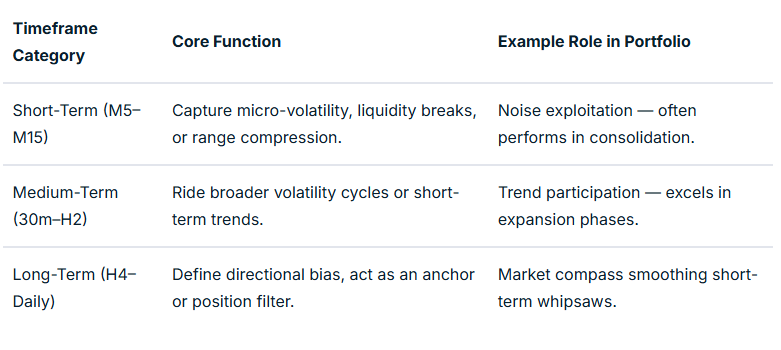
Asset Balance: Managing Systemic Correlation Risk
Running five different EAs on USDJPY might feel diversified if each uses different entry logic, even though they share the same systemic market driver.
But in an EA context, correlation measurement is not necessarily between prices, but between EA returns (equity changes) relating to specific strategies in specific market conditions.
Two EAs on the same symbol might use completely different logic and thus have near-zero correlation.
Conversely, two EAs on a different symbol may feel as though they should offer some balance, but if highly correlated in specific market conditions may not achieve your balancing aim.
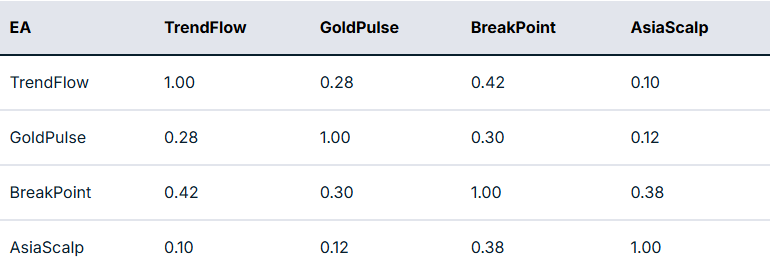
In practical terms, the next step is to take this measurement and map it to potential actionable interventions.
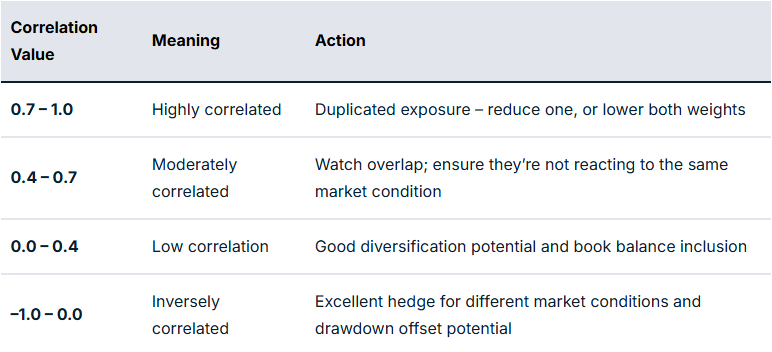
For example, if you have a EURUSD Trend EA and a GBPUSD Breakout EA with a correlation of 0.85, they are behaving like twins in performance related to specific market circumstances. And so you may want to limit exposure to some degree if you are finding that there are many relationships like this.
However, if your gold mean reversion EA correlates 0.25 compared to the rest of your book, this may offer some balance through reducing portfolio drawdown overlap.
Directional and Sentiment Balance
Markets are commonly described as risk-on or risk-off. This bias at any particular time is very likely to impact EA performance, dependent on how well balanced you are to deal with each scenario.
You may have heard the old market cliché of “up the staircase and down the elevator shaft” to describe how prices may move in alternative directions. It does appear that optimisation for each direction, rather than EAs that trade long and short, may offer better outcomes as two separate EAs rather than one catch-all.
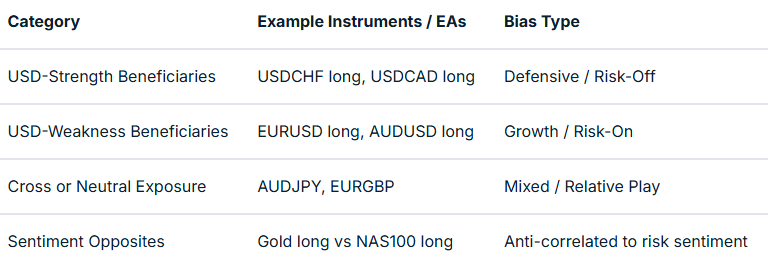
Market Regime and Volatility Balance
Trend and volatility states can have a profound impact on price action, whether as part of a discretionary or EA trading system. Much of this has a direct relationship to time of day, including the nature of individual sessions.
We have a market regime filter that incorporates trend and volatility factors in many EAs to account for this. This can be mapped and tested on a backtest and in a live environment to give evidence of strategy suitability for specific market conditions.
For example, mean reversion strategies may work well in the Asian session but less so in strongly trending markets and the higher volatility of the early part of the US session.
As part of balancing, you are asking questions as to whether you actually have EA strategies suited to different market regimes in place, or are you using these together to optimise book performance?
The table below summarises such an approach of regime vs market mapping:
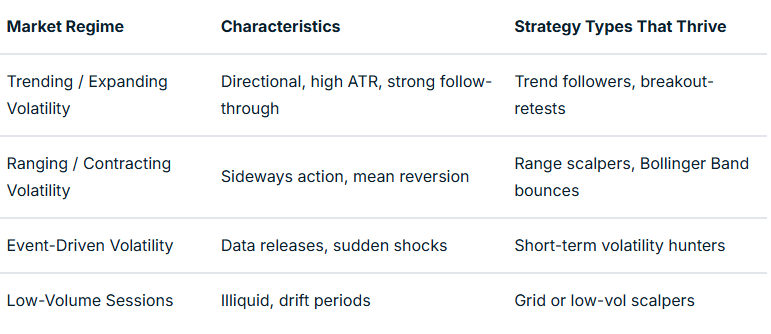
Multi-Level Analysis: From Composition to Interaction
Once your book is structured, the challenge is to turn it into something workable. An additional layer of refinement that turns theory and measurement into something meaningful in action is where any difference will be made.
This “closing the circle” is based on evidence and a true understanding of how your EAs are behaving together. It is the step that takes you to the point where automation can begin to move to the next level.
Mapping relationships with robust and detailed performance evaluation will take time to provide evidence that these are actually making a difference in meeting balancing aims.
To really excel, you should have systems in place that allow ongoing evaluation of the approaches you are using and advise of refinements that may improve things over time.
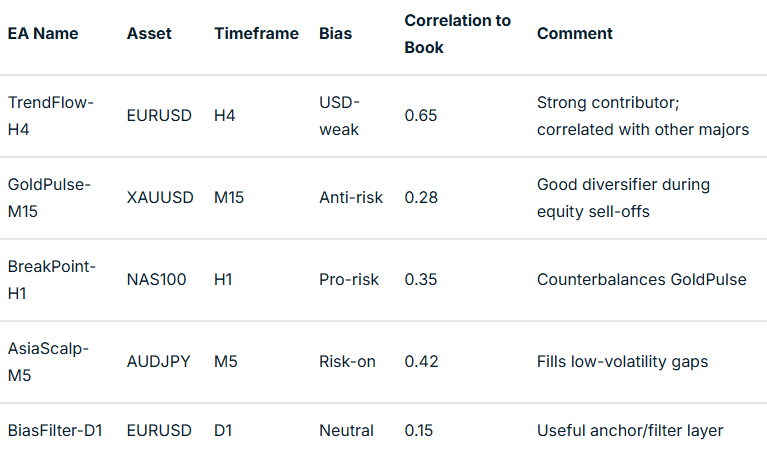
What Next? – Implementing Balance in Practice
Theory must ultimately translate into an executable EA book. A plan of action with landmarks to show progress and maintain motivation is crucial in this approach.
Defining classification tags, setting risk weights, and building monitoring dashboards are all worth consideration.
Advanced EA traders could also consider a supervisory ‘Sentinel’ EA, or ‘mothership’ approach, to enable or disable EAs dynamically based on underlying market metrics and external information integrated into EA coding decision-making.
Final Thoughts
A balanced EA portfolio is not generated by accident; it is well-thought-out, evidence-based and a continuously developing architecture. It is designed to offer improved risk management across your EA portfolio and improved trading outcomes.
Your process begins with mapping your existing strategies by number, asset, and timeframe, then expands into analysing correlations, directional bias, and volatility regimes.
When you reach the stage where one EA’s drawdown is another’s opportunity, you are no longer simply trading models but managing a system of EA systems. To finish, ask yourself the question, “Could this approach contribute to improved outcomes over time?”. If your answer is “yes,” then your mission is clear.
If you are interested in learning more about adding EAs to your trading toolbox, join the new GO EA Programme (coming soon) by contacting [email protected].


With very rare exceptions every trader must battle with trading discipline at stages in their trading career. Commonly when we explore trading discipline, there is an obvious focus on what we will term “execution discipline”, that is engaging and following through with elements of your trading plan e.g. adhering to a pre-planned exit strategy. However, becoming a better trader is more than simply doing what you say you will do with direct trading actions.
It also involves developing a structured plan for learning trading (fostering improved knowledge and confidence), creating those systems that support the development of that plan you intend to execute, discipline in learning and system development. Quite simply, discipline in learning gives you the tools to develop and creates effective systems (and measure them) without these, and a subsequent belief and confidence that they could work for you when trading, it becomes significantly more difficult to be disciplined in the execution of direct trading actions. So, in reality all these areas are interrelated in terms of potential trading outcomes.
With many traders knowing where to start and what to do to address the challenges of mastering trading discipline is a barrier to moving forward. In a recent ‘Inner Circle’ session (find out more about joining this group here ), we aimed to assist those in this position and outlined a six-step process to facilitate this. These steps are: 1.
Develop awareness and OWN your behaviour. 2. Explore potential cause(s) and prioritise areas for “work”. 3. Create the motivation to consider change through evidence. 4.
Action plan and follow-through 5. Lock in the new change 6. Measure and move on to next issue.
This first article in this series focuses on the first of these steps, with subsequent articles addressing the other steps. Developing awareness of where you are now not only assists in providing a benchmark as to where you are now but allows prioritisation of areas to address that will tighten your trading behaviour. Additionally, of course, through doing an exercise to develop this awareness, this facilitates some “ownership” of where you are now, i.e. being responsible for what you are doing well, and more importantly what areas need improvement.
This is invaluable as it moves away from the all to common blaming of the markets, or your system for your results. After all, two things are clear and indisputable: a. You have control and responsibility for all trading actions and hence are completely responsible for the results you get from trading.
This includes creation and evaluation of the trading system you are using. Logically, although this fact seems to escape many, you can’t even reasonably begin to “blame” a system for your results until you are following it religiously. As soon as you stray it becomes a “you” issue, rather than a system issue. b.
You are in control of what happens from now. Previous results, and the behaviours that led to these, serve only to give you “feedback” as to what you need to do next, the good news being of course that you CAN, with the ownership of discipline issues, make the changes you need to. So, with the theoretical justification covered now onto the practical.
To assist in your development of this ‘awareness’, crucial to the subsequent five steps, we have a “15-point discipline checklist” for you to download and complete to give you this opportunity to benchmark and consequently begin to prioritise and work upon. Although we previously referenced the interrelated nature of the three critical discipline areas - discipline in learning, discipline in systems, and discipline in execution, we have used these three areas as a framework to make identification of those areas that you need to work on, a little easier. So, your mission is clear for this first step: a.
Download the attached checklist below b. Complete it and then identify the three areas you think could make the most difference to your trading c. Watch out for the next article in this series where will give you additional information to move onto step 2.
Discipline checklist amended 3


The ability to set up phone notifications for trading activity on your MT5 platform has many advantages including of course the opportunity to “Check-in” on the market whist on the move. It could be argued that this ability goes beyond simple convenience and in the case of “pending orders” could be viewed as an important part of risk management of trades that are opened through this method. Pending orders revisited Pending Orders are advanced entry orders that allow you to place an order onto the system that will be filled at a specific price level.
The key potential advantage is that you don’t have to be watching the market continuously for an order to be filled, and it can be filled at any time if the order is still active on the system. An example could be placing a “Buy Stop” order above an identified resistance level, so if the relevant currency pair or CFD moves to this price point then the order will be filled at your chosen price (You can still place a stop loss and profit target associated with the pending order). Although it a potentially attractive function of your Metatrader platform, one of the potential disadvantages is that without notifications set up you may not be aware that a trade has been entered until you are in a position to look at your trading platform on your PC for example.
Without this awareness of an “open” trade, the implications are: You will not be able to adjust a “trail stop” to lock in potential profit if the trade does go in your direction In the event of imminent economic data, you will not know to adjust such open positions to manage risks associated with this. Setting up phone notifications on your phone, is not only relatively simple but mitigates these potential disadvantages. Setting up notifications We will walk you through the set-up process on MT5 but is similar if you are using MT4.
Download the MT5 app on your mobile phone Allow to send “notifications”. Check in phone settings that it is set up. Open the app and go to messages in settings and find your Metaquote ID at the bottom of the screen.
Make a note of this (See diagram below). Open the MT5 platform on your PC In the tools menu, click on options and then the notifications tab. Enter your MetaquoteID in the pop-up box as shown below.
Click on test You should receive a notification on phone that set up is complete and subsequently with any orders you place and that are filled. Of course, feel free to contact the GO Markets team if you need additional support in setting this up at any time.


When we first start to trade, or subsequently (as a more experienced trader) when we trade a new symbol or system we are often “excited” as we see a “hope” for better results. We often forget that the development of expertise in other areas we have in life (think about what you do in work now for example), you must invest time, effort, learning and making mistakes (providing you acknowledge and learn from them) to develop. This is not an overnight transformation, rather it may take several weeks if not months before you feel confident in your knowledge and skills.
It is bizarre therefore that we should expect anything different with trading development. To be clear, we respect and commend those who take the leap and move from demo to live account. After all, a demo platform ( you can trial a MetaTrader 4 or MT 5 demo account here ) will serve you in learning how the platform works, how to add indicators and get used to how markets move.
However, it is only when you start to have some “skin in the game” and are trading YOUR money, albeit with tiny positions to start with that you learn the most important lessons in trading and develop the appropriate mindset to begin to think about trading larger positions. All that been said, we see time and time again new traders or those trading a new system exhibiting three cardinal sins of the developmental trader, and decide to trade: a. With positions that are too big b.
Short cutting learning and system development c. Strategy skipping (i.e. moving from new system to new system) without meaningful measurement as to what works for you (and what doesn’t) or indeed whether the problem is YOU failing to trade a system religiously. These are all symptoms of impatience, of wanting to get massive returns quickly and without putting the hard yards in at the front end.
Remember this... The purpose of your trading when you start trading a live account should not be huge profit, rather it is to develop the confidence in your system, consistency in action and the measure whether what you are doing could be improved. Although it may seem strange to suggest, it is this and not, in the early stage of trading, the money (and level of profit) is most relevant in your potential lifelong career as a trader.
It is through patience, and adhering to that initial purpose that you can gain sufficient confidence and competence to trade larger positions (after all it is just moving a decimal point to go from 1 mini-lot to a standard lot) and put the right foundations in to move forward. Exercising patience to have the right things in place will serve you well for a potential lifetime of trading, to be impatient may mean your trading lasts but a few weeks or months. It is really that simple.


Position sizing is simply the number of contracts that you choose to enter for any specific trade. It is this, combined with the movement in price (either positively or negatively) from entry to exit in your trade, that determines your final dollar result for any specific trade. As this result impacts on your trading capital, position sizing, along with appropriate exit decisions and actions, are THE two key factors in both risk management and taking profit.
It is good trading practice to have a “tolerable risk level”, i.e. what you are prepared to lose on a single trade. This, as we have covered in First Steps, is usually expressed as a percentage of your total trading capital (somewhere between 1-4% are commonly used). For example, If your chosen risk level is 3% and the capital in your account is $5000, this means that you would be prepared to risk $150 on one trade.
Why use formal position sizing? A formal position sizing system aims to answer the question “how many lots do I enter to keep any loss within my tolerable risk level if my stop loss is triggered?”. As we enter a trade, we ALL position size, but we have a choice as to how we action this.
We can: Guess. Use a dollar level i.e. when it hits this we are out (you can retrospectively modify a stop level on a trade chart on your trading platform). Use a technical level as a stop loss and work out how many contracts we can enter based on the Pip movement between entry and stop.
Logically, “3” would seem the most robust AND this should be calculated BEFORE entering a trade. So how do I position size? Accepting that the third of the options above is theoretically the optimum method, the process is: a.
What is my “tolerable risk level” in dollar terms? b. What is the desired technical entry and stop loss price levels? c. What is the dollar difference between entry and stop loss exit? d.
Divide ”a” (your tolerable risk level) by “c” to get an estimated position size. If your account is in Australian dollars the calculation is easier than trading either many index CFDs (except for the ASX200) or Forex as there is no need to add a further calculation to convert a profit/loss back into your account currency. Other position sizing issues to consider: Position sizing can only make a difference to your risk management if you adhere to your pre-planned exit strategy.
Be aware of gapping on market open from previous close price. This is at its potentially most severe subsequent to a company’s earnings report release and so you may want to consider avoiding this situation as part of your risk management plan. Once you have mastered basic position sizing, consider whether different market conditions or situations would merit a different tolerable risk level on which to base your position sizing calculations. e.g. a major economic news release increased general market volatility.
In such situations it may be that you enter a smaller position initially and then accumulate into the position if it goes in your desired direction. There is a FREE DOWNLOAD of an excel-based “indicative CFD position size calculator” you are welcome to use to assist you in this important part of trading entry. Feel free to use, but please pay attention to the notes.
Click on the link below. CFD position size calculator v2 Please feel free to connect with the team with any questions you have about share CFDs and how you can add this to your trading.


We frequently refer both in the articles we publish and the weekly “Inner Circle” sessions we present, to the benefits of a trading journal. However, the reality is that many traders make the choice not to measure trading despite the logical benefits of doing so. Whether you do or don’t currently, the bottom-line decision you are making is not only whether you do or don’t but how that positions yourself with your trading development.
We would suggest that this overall choice can be broken down into the following three sub-choices. You can make the decisions that are right for you subsequently. Sub-choice 1 - Measuring your system You are either making the choice to: Have certainty on not only whether your trading plan as a whole can create positive outcomes but have evidence to know which component parts of your plan are e.g. indicators you use for entry and exit, comparing strategies you trade, timeframes that work best for you, (and which are not) contributing to such outcomes.
Additionally, it allows you to compare what would happen if you change some of the perimeters on your potential results. OR You have no evidence as to whether your system as a whole and its components parts are working well to serve you in getting the results you desire. Nor do you can test and gather evidence as to what the impact of nay changes you may make to that system, Ask yourself… If I am serious about trading results which choice should I make?
Sub-choice 2 - Measuring you as a trader You are either making the choice to: Know the degree to which you are following your plan or otherwise so you can ultimately make a judgement on: a. Whether your system is working for you (all the points in sub-choice 1 above CANNOT be made unless you are following your plan religiously). b. What you need to work on in terms of tightening your behaviour e.g. on exits or entry c.
Whether there are certain market conditions which you find difficult or are ill-prepared for (so you can fill any knowledge gaps or avoid in the future). OR You can continue to trade as you do, avoiding any self-assessment and growth, and the refinement of your behaviour that may contribute to more positive trading outcomes. Ask yourself… If I am serious about trading results which choice should I make?
Sub-choice 3 - Improving your trading (closing the circle) (let’s assume you are keeping a journal for this one) You are either making the choice to: Measure with purpose that has clear follow through into further development and refinement of your trading plan and subsequently your actions. This facilitates the development of you as a trader based on your individual character and trading style. In practical terms, you ‘close the circle’ with a defined review and develop an action plan based on your review to test and change parts of your plan.
This is evidence-based trading! OR You can measure for measurements sake to on the surface appear to be “doing a right thing” but in reality, failing to unleash the real power of journaling, that is to make an on-going and continuous positive difference to your trading outcomes. Ask yourself… If I am serious about trading results which choice should I make?
In summary, if you have made the choice to read this article to its end you are left with one ultimate choice…to journal or not to journal including the three sub-choices that dependent on which you are making can impact on your trading. So, for one last time, Ask yourself… If I am serious about trading results what should my actions be with what I have read in this article? Our next steps and Share CFD education programme both have indicative trading journal templates to help get you started, and we would be delighted if you could join us.
Drop us a line, click on this link HERE, or give us a call if you want further information on either of these FREE programmes of learning.


A written trading plan, usually comprising of several guiding action statements, serves the following two invaluable purposes: Facilitates consistency in trading action e.g. in the entry and exit of trades, allowing the trader AND Measures the strategy used specified within each statement to make an evidence-based judgement on how well these are serving you and test and amend these statements so you can develop an individual trading plan that may work better for you. Let’s move past the fact that many traders choose not to have a plan at all, an approach that goes against what is one of the key components of giving yourself the chance to become a successful trader, to those who have a plan in place already. This article is targeted a those who have made the logical choice to have some sort of written plan in place.
Great though having a plan is, many traders still have issues with the two purposes outlined above. They still fail to some degree to develop the consistency described and are not really able to measure effectively. A common problem, if we look closely at some of the plan statements used, is that such statement may not be specific enough, have some ambiguity, that means that those purposes may be difficult to achieve.
Let’s provide and work through an example for clarity. Consider the following statement… “I will tighten my stop/trailing stop prior to significant, imminent economic data releases” Firstly, on the positive side again, this does demonstrate an awareness of potential risk and a desire to have something within your plan to manage this risk. However, in terms of being a measurable statement that you can make a judgement as to how well this approach is serving you, there are the following issues: What does ‘tightening’ mean in practical terms in relation to current price point of the pair you are trading?
How close to a data release is ‘imminent’? What constitutes a significant data release (amongst the many that are released daily)? So, to take the previous example consider the following as an alternative: “Prior to imminent economic data releases, I will tighten of a trail stop loss for any open trades, 15 minutes prior to the release and to within 10 Pips of the current price.
This will be actioned for the following data points: Interest rate, CPI, industrial production and jobs data from the country of either currency pair (or Germany, France of across the Eurozone if one of the currency pair is the EURO). US and Chinese PMI manufacturing data, GDP, industrial jobs and interest rate decisions as these may impact all currency majors." So, with THIS amended plan statement the following elements could be measured (if journaled appropriately of course): What would the difference be in your trading outcomes if: No tightening had been actioned. If a different proximity to current price is used e.g. 15 rather than 10 Pips.
If other data releases are added/removed. With this level of measurement, possible with the revised statement, one would now be able to make any changes, backed up with evidence, to your trading plan. Alternatively, of course, you could make the choice to do nothing, retain statements such as the original, and not have the ability to create the richness of evidence to make considered amendments to your plan.
Logically ask yourself the question, "which choice is more likely to serve my trading going forward?"

